Pilkington Jackson
Charles d’Orville Pilkington Jackson ARSA, FRBS, FRSA (11 October 1887 – 20 September 1973) was a British sculptor prominent in Scotland in the 20th Century. Throughout his career he worked closely with the architect Sir Robert Lorimer. He is most noteworthy for his creation of one of Scotland’s iconic landmarks, which appears in much promotional material about Scotland: the statue of Robert the Bruce at Bannockburn.
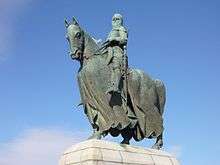
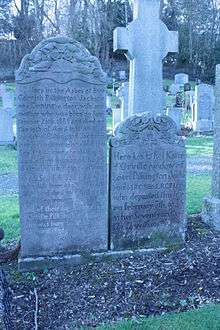
Early life
Charles d'Orville was born at Garlenick near Grampound, Cornwall the son of Ethel Katie D'Orville.[1] She married Louis Pilkington Jackson soon after, who may be presumed to be Charles' father, leading him to adopt his name in later life.
Charles attended the Edinburgh Institution from 1905 and the newly established Edinburgh College of Art in 1907, studying design and sculpture.[2] He graduated in 1910 and received a travelling scholarship of £100, which he used to visit the British School in Rome. Whilst in Rome he worked with Giacomo Boni on the rebuilding of the Arch of Titus.[2]
Career
In 1911, on his return to Scotland, he established himself in a studio with William MacDonald, a bronze founder. During World War 1 he served with the British Army as a subaltern in the Royal Field Artillery and the Intelligence Corps in Egypt and Palestine, being Mentioned in Dispatches.[2]
After the war he received numerous commissions to design war memorials and these extend across the whole width and breadth of Scotland. He was appointed as "supervising sculptor" for the Scottish National War Memorial, which was planned and built within Edinburgh Castle between 1919 and 1927.[1] He was also commissioned to create numerous memorials to famous Scots, including tableaux at the David Livingstone Centre, and a memorial to Elsie Inglis, on which he collaborated with Sir Frank Mears.[2] In 1929 he went on holiday to Sweden with Robert Lorimer[3] and visited the eminent Swedish sculptor Carl Milles whom he acknowledged as a great influence on his work.[2]
In the Second World War, although being far beyond the age of conscription at 52, he again joined the army, this time serving in Scotland as a Gun Operations Room Officer for coastal defence guns. He had an extremely long working career leading to his most famous commission, the statue of Robert the Bruce being executed in 1964 at the age of 76. The mounted statue of Robert the Bruce forms the focal point of the memorial to the 1314 Battle of Bannockburn, and is sited to face southwards, from which direction the English army approached. The statue and monument are listed at category A, and are included as one of the 60 DoCoMoMo Key Scottish Monuments of the post-war period.[4][5] A copy of this sculpture stands at the Alberta College of Art and Design in Canada, and an alternative version of the monument, showing Bruce on a rearing horse, was later installed at the Chivas Brothers Distillery in Paisley.[1]
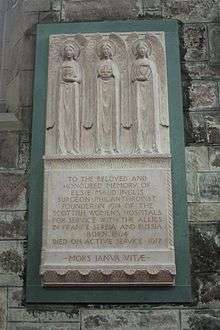
Pilkington Jackson exhibited regularly at the Royal Scottish Academy, and was elected as an academician in 1956. He also served on the Royal Fine Art Commission for Scotland, and taught at Edinburgh College of Art in the late 1920s.
Death
Pilkington died in Edinburgh on the 20 September 1973.[2] His body was cremated and its ashes were buried at Lasswade Cemetery, at the North end of the modern section. He designed both his own gravestone (following the death of his wife, Eve Cornish Dening, 1885-1951), and that of his parents, which stands alongside. His son, Richard D'Orville Pilkington Jackson (1921-2009), was interred in the same grave.
Principal works
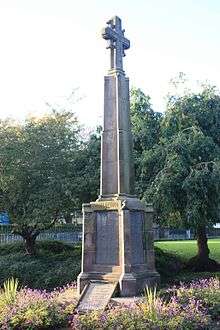

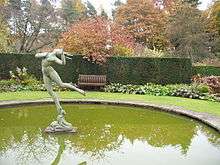
- Plaque to Sophia Jex-Blake at Edinburgh University’s Medical School (1912)
- Memorial to Dr Ramsay Traquair Colinton Churchyard (1913) (to a design by Traquair’s wife)
- Memorial to his daughter-in-law Harriet E. Moore in Morningside Cemetery, Edinburgh (1919)
- Sculpture on the Scottish National War Memorial (1919-1927) at Edinburgh Castle in conjunction with Sir Robert Lorimer
- Markinch war memorial (1920)
- Tarbrax war memorial (1920)
- West Linton war memorial (1920)
- Balquhidder war memorial (1920)
- Haddington war memorial (1920)
- St Mary’s Episcopal Cathedral War Memorial (1920)
- Memorial to the 5th Battalion Royal Scots in the Great War, St. Giles Cathedral (1920)
- “Scotsman” office war memorial (1921)
- Dalbeattie war memorial (1921)
- Castle Douglas war memorial (1921)
- Bank of Scotland war memorial in Head Office, The Mound, Edinburgh (1921)
- Heart of Midlothian war memorial, Haymarket, Edinburgh (1921) (Removed 2012 due to Edinburgh Trams project).
- Kelso war memorial (1921) with Sir Robert Lorimer.
- Rothesay war memorial (1922)
- Colinton war memorial (1922)
- Coldstream war memorial (1922)
- Keith war memorial (1922)
- Royal Bank of Scotland war memorial in Dundas House (1922)
- Edinburgh Academy war memorial (1922)
- Loretto School war memorial (1922)
- Eton College war memorial (1922)
- Elsie Inglis memorial St Giles' Cathedral (1922) (with Sir Frank Mears)
- Royal Army Medical Corps war memorial, St. Giles Cathedral (1923)
- Edinburgh University war memorial in Old College (1923)
- Group of three medallion heads in St. Giles Cathedral to John Stuart Blackie, Thomas Chalmers and Dr John Brown (1923)
- Angel corbels and stone communion table, Paisley Abbey (1923-6)
- Replacement head (in bronze) on the tomb of the 9th Lord Belhaven and Stenton (originally by William Birnie Rhind, 1896), Dean Cemetery (1924)[6]
- Alloa war memorial (1925) in conjunction with Sir Robert Lorimer
- Choir screen, St Serfs Church, Ferry Road, Edinburgh (1926)
- Workington war memorial (1927)
- Decoration at Stowe School (including chapel) (1927)
- Sculpture of pelican, porch wall, St Andrew's Garrison Church, Aldershot (1927)[7]
- Earl Haig Memorial (bust), Scottish National War Memorial, Edinburgh Castle (1928)
- Leslie war memorial (1929)
- Pair of low relief gilded bronze heads flanking the Thistle Chapel in St. Giles Cathedral to James Cameron Lees and Andrew Wallace Williamson (1931)
- A series of bronze tableaux depicting the life of David Livingstone for the David Livingstone Centre at Blantyre (1929)[8]
- Series of 82 military statuettes for the United Services Museum in Edinburgh Castle (1929–33)
- Mock 16th century inscriptions on the front of Huntly House, Canongate, Edinburgh (1930)
- Monument to the child author Marjorie Fleming in Kirkcaldy Parish Church (1930)
- Bust of Gerard Baldwin Brown, Edinburgh University (1931)[9]
- Robert Lister Bower memorial (1931)
- Memorial to King Khama III (1933)
- Sculpture over entrance, Dundee Street Library, Edinburgh (1938)
- Foam, fountain at the Empire Exhibition Glasgow (1938)
- Repairs and WW2 additions to Sheffield war memorial (1946)
- Fettes College war memorial WW2 additions and extension (1947)
- "Orographical Globe" at Eton College (1948)
- Dunkeld war memorial (1948)
- Devondale war memorial (WW2) in Tillicoultry (1949)
- "Henge-style" monument to the Royal Scots at the east end of Princes Street Gardens (1950) (with Sir Frank Mears)
- 603 Squadron memorial, Edinburgh (1950)
- Creation of a formal ceremonial Mace for St. Andrews University (1950)
- Memorial to Sir John Maxwell Erskine (1951)
- Cupar war memorial WW2 additions (1951)
- Carvings for Adam House, Chambers Street, Edinburgh (1954)
- Badges signs and logos for the Scottish Tourist Board (1954–56)
- Bust of James Clerk Maxwell for University of Aberdeen, Marischal College (1956) A later copy is displayed at the James Clerk Maxwell Foundation
- Bronze bust of Frederick Lugard for the National Portrait Gallery, London (1960)
- Royal Scots Fusiliers memorial, Ayr (1960)
- National landmark, the statue of Robert the Bruce mounted on a war-horse at Bannockburn in the centre of the battlefield (1964)
- Fibreglass sculpture of Robert the Bruce on a rearing horse (a working model not chosen for use on the Bannockburn site) at the Chivas Brothers Distillery in Paisley (1964)
- La Poliche Libre at the Royal Scottish Academy (1972)
Minor Works of Interest
- Monument to John Charles Fraser Gibson, killed in a plane crash in Mombasa 1945, St. Serfs Church, Ferry Road, Edinburgh (1946)
References
- Nisbet, Gary. "Charles d'Orville Pilkington Jackson (1887-1973)". Glasgow - City of Sculpture. Retrieved 27 February 2014.
- "Charles D'Orville Pilkington Jackson ARSA, FRBS, ARBA". Mapping the Practice and Profession of Sculpture in Britain and Ireland 1851-1951. University of Glasgow. 2011. Retrieved 27 February 2014.
- Dictionary of Scottish Architects: Robert Lorimer
- Historic Environment Scotland. "Bannockburn, rotunda, memorial cairn, flagpole and statue of King Robert I (Category A) (LB49860)". Retrieved 28 March 2019.
- Glendinning, Miles, ed. (1997). Rebuilding Scotland: The Postwar Vision, 1945-1975. Tuckwell Press. p. 153. ISBN 1-898410-33-X.
- Buildings of Scotland: Edinburgh by Gifford McWilliam and Walker
- National Library of Scotland Inventory Acc. 7445
- West, Jean (13 October 2019). "David Livingstone carvings restored in Scottish museum revamp". The Sunday Times. ISSN 0956-1382. Retrieved 16 October 2019.
- ""Gerard Baldwin Brown"". ed.ac.uk.
- Papers of the late Charles D'Orville Pilkington Jackson Esq, National Library of Scotland, Inventory account 7445
- McWilliam, Colin; Gifford, John; Walker, David (1984). Edinburgh. The Buildings of Scotland. Penguin. ISBN 978-0-14-071068-7.
External links

- Charles d'Orville Pilkington Jackson (1887-1973), Sculptor, in the collection of the National Portrait Gallery, London